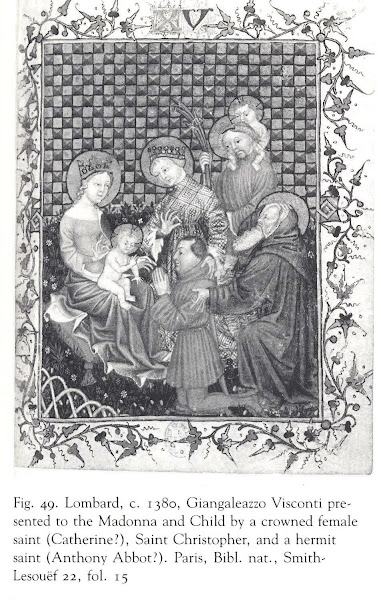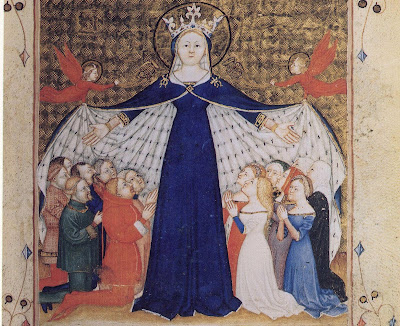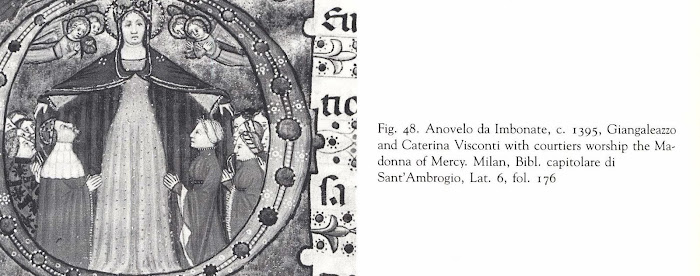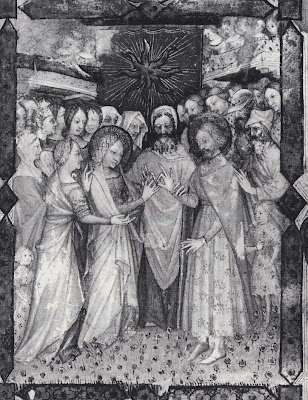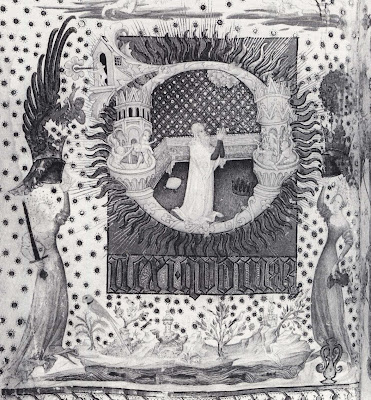Phaeded: Thanks for the quotes about Manfreda. I don't disagree; but the knot in the card also applies if she stands for an abstraction, Christ's Church. And the knot is as much secular as sacred, as much about faithfulness in marriage as about the Holy Trinity. It is a question of levels of interpretation.
I do not make much of the unbound hair. As I say, none of the Female Pages in the CY have unbound hair. While there were no female pages as such in the court, they would have corresponded to ladies-in-waiting, who traditionally were unmarried. It is just something to be noted for further research.
I see no garland on the Chariot lady's head, just the usual headpiece, this time in gold.
On consummation: In the wedding portrait of Giangaleazzo and Caterina, consummation is as much a concern as in the wedding of Bianca Maria and Francesco Sforza--or any dynastic marriage. Perpetuation of the line is one of the main goals of such a marriage. But the primary thing in both cases is love of the divine. Eros may be pagan, but it has both divine and secular levels, which has its Christian version in the marriage of Christ with his Church and the sacrament of marriage, which is both secular and divinely sanctioned.
That brings me to my next example of a marriage commemoration, in the next manuscript of Giangaleazzo's that Kirsch discusses, one that explicitly refers to consummation and progeny; she calls it the Florence Psalter-Hours, and is now separated into two manuscripts, Banco Rari 397 and Landau-Finaly 22. The first part was mostly completed during Giangaleazzo's time. The second part was only sketched out and was completed on Filippo's commission. Kirsch begins her chapter III (p. 40):
There is no doubt that the patron who commissioned the Psalter-Hours in Florence (Banco Rari 397 and Landau-Finaly 22) was Giangaleazzo Visconti. He is named twice in the second volume of the manuscript (on LF 9v and LF 22), and his armorials appear throughout both volumes. The date of the Psalter-Hours is undocumented; however, the structure, iconography, and style of the manuscript, as well as evidence concerning its scribe and illuminator, all point to the period around 1388, the year of the birth of the first child of Giangaleazzo and Caterina Visconti--a son, Giovanni Maria, who was to become the second Duke of Milan. Thus, the Florence Psalter-Hours may be understood as a sequel to the Paris Hours-Missals, which, as suggested in chapter II, commemorated the marriage of Giangaleazzo and Caterina.
What corresponds in the time of the CY, of course, is the birth of Francesco and Bianca Maria's first-born in 1444, a likely time for the CY to have been made. The Florence Psalter-Hours is a precedent for miniatures of a different kind, in the form of cards, on commission of Giangaleazzo's successor. This precedent, seen by Kirsch, has no doubt been seen by others: Kirsch observes (p. 42):
Princess Giulia Rospigliosi (nee Visconti di Modrone) believes that the manuscript [BR 397] may have been bought in the nineteenth century by her grandfather, Raimondo, whose historical interests prompted him to acquire other objects connected with his family, including the tarocchi painted for Filippo Maria Visconti and now in the Beinecke Library at Yale university (Fig. 61). Footnote: Giulia Visconti di Modrone Rospigliosi kindly discussed with me the history of her family's collection. The Visconti di Modrone tarot cards are now at Yale University in the Cary Collection of Playing Cards, No. ITA 109 (New Haven, Yale, no. 51).
Figure 61 is of course the CY Love card. I showed her reproduction and its annotation in the first post of this thread.
That these Hours are extant is itself something of a lucky thing. She quotes from a letter of Bianca Maria's in 1447 (I give Kirsch's English translation, p. 43 n. 11):
"There (in the arms storeroom) was the Book of Hours of the above-mentioned Lord in a (stamped) leather binding, covered with crimson velvet, and with clasps in the shape of knotted cloth which, according to many trustworthy persons, cost two thousand ducats."
This was shortly before the sack of the castle and the proclamation of the Ambrosian Republic. Kirsch says that the whole letter is in L. Beltrami,
Il Castello di Milano, 1894, 48. The rest of it might be of interest to tarot researchers. I omit Kirsch's half a page justification of her conclusion that the book rescued is the manuscript we now have in two parts. If it had not been saved, moreover, no one could have believed that it ever existed. It is not in any of the inventories of the Visconti and Sforza libraries, Kirsch says. (I make no explicit analogy to tarot decks.)
In 1380, when Giangaleazzo married Caterina, he had two children by his previous marriage. By 1380 he had only one, the girl Valentina. Thus dynastic concerns were paramount. In 1386 they had become even more urgent, because in placing the daughter in an advantageous marriage, to the brother of the king of France, Giangaleazzo had had to agree, as part of her dowry, that should the male Visconti line die out, all of his dominions would be forfeit to Valentina and her descendants. (Kirsch cites Jarry, 23-43, for the marriage negotiations.) It was on this pretext, in fact, that Louis XII invaded Milan in 1499, since Filippo had died without an heir in 1447. So in issuing a tarot deck, there would have been some presumption that it celebrated the birth of an heir (a presumption that Sforza, probably rightly, would have considered a ruse).
Galeazzo and Caterina's son was born on the eve of feast of the Nativity of the Virgin. In gratitude, Giangaleazzo made that day an annual holiday with "processions of the guilds from the city gates to the basilica of Santa Maria Maggiore, then in an early stage of transformation to the present cathedral of Milan" (p. 47). The new cathedral was subsequently dedicated to Santa Maria Nascente. In further gratitude, he vowed to name his son "Maria", as well as any further sons born to him. Even an illegitimate son was named after the Virgin (Gabriele Maria, later legitimized and inheritor of Pisa and Crema), and in fact a daughter, too, as we know.
Kirsch contends that the Psalter-Hours is another expression of gratitude to the Virgin. It recounts in detail, from various sources, the life of the Virgin, including the events surrounding her birth. The frontispiece shows the marriage of Anna and Joachim, who are childless until late in life, when surprisingly Mary is born. I give a link to the full illustration, and the relevant detail as an image here.
http://4.bp.blogspot.com/-RWhSqXDPmt0/U ... hFig65.jpg
Here is the beginning of Kirsch's analysis (p. 50):
The Marriage of Anna and Joachim on BR 1 (Fig. 65) is accorded unusual prominence in the Psalter-Hours, where it introduces the manuscript as well as the extraordinary Marian cycle. Whereas Visconti emblems are restricted to the borders on all other pages containing narrative episodes in the cycle, the onl device on BR 1--a radiant sun, the personal emblem of Giangaleazzo, never used before him by a Visconti--is incorporated into the scene itself, where it adorns the hanging beyond the wedding group. The position of this emblem suggests that the Marriage of Anna and Joachim refers also to the wedding of Giangaleazzo Visconti and his cousin Caterina, an implication sustained not only by other aspects of the miniature on BR1 but also by the entire Marian sequence of the Psalter.
Compelling similarities exist between the face of the young Joachim on BR 1 and the three surviving portraits of Giangaleazzo and Caterina. Although children are sometimes present in the depictions of the Marriage of the Virgin, from which the composition of the Marriage of Anna and Joachim is derived, those on BR 1, similarly dressed, as brother and sister might be, probably represent Giangaleazzo's son and daughter by his first marriage: Azzone and Valentina, who were eleven and ten years old when their father remarried in 1380.
I omit the paragraph in which Kirsch discusses precedents for the identification of a patron with a holy figure: they are sufficient. She then turns to the question of whether such an illumination would have been understood in this way by later rulers of Milan descended from Giangaleazzo. She says (p. 51):
That the Marriage of Anna and Joachim on BR 1 (Fig. 65) was understood by Giangaleazzo and Caterina Visconti's great-grandson, Galeazzo Maria Sforza, as a representation of his great-grandparents wedding is almost certainly proved by a manuscript painted for Galeazzo Maria in 1476 by Cristoforo de' Predis. At the beginning of a long pictorial narrative that opens with the story of the Virgin's parents and ends with eschatological subjects, both the betrothal and marriage of Anna and Joachim are depicted among an array of Galeazzo Maria's devices, including the fleur-de-lys worn both for Galeazzo Maria in a portrait now in the Uffizi and by Joachim in the Turin wedding miniature. (42)
Footnote 42: Kirsch, 1981, figs. 69-71. The Turin manuscript is Biblioteca Reale, Var. 124 (Milan, 1958, no. 344, and Cipriani, 1959, 74). As in the instance of Giangaleazzo in the Psalter-Hours, the identification of Galeazzo Maria with Joachim in the Turin manuscript is implied through settings and armorials. Galeazzo Maria acquired the fleur-de[lys as an emblem through his marriage in 1468 to Bona of Savoy, sister-in-law to the King of France.
Around 1477, Cristoforo de' Predis painted a miniature portraying Galeazzo Maria Sforza as David in an initial illustrating Psalm 24 (Fig. 68--London, Wallace Collection, M342; see M. Jacobsen, "A Sforza Miniature by Cristoforo da Preda," Burlington Magazine CXVI, 1974, 91-96. Here the extravagant array of armorials clearly evokes the Psalter-Hours, and the very outline of the initial, an architectural structure inhabited by putti, is a transposition into a late fifteenth-century idiom of forms in the Visconti Hours (cf. BR 108v--Fig. 59). On the identification of Giangaleazzo Visconti with David int he Visconti Hours, see page 52 below.
Kirsch does not reproduce de' Predis's "Marriage of Anna and Joachim," but she does give us his "David," below.
http://2.bp.blogspot.com/-NlaUYPyadqg/U ... hFig68.JPG
I assume that David is praying for a son, after his first child by Bathsheba was stillborn. The parallel is with the Psalter Hours' similar illumination of David, in Giangaleazzo's Psalter-Hours, Kirsch's Fig. 59, BR 397 fol. 108v:
http://1.bp.blogspot.com/-PryPBY94X4E/U ... hFig59.JPG
The representations of Justice and Temperance on the sides are in accord with Giangaleazzo's title as Count of Virtues. These representations are not wholly conventional; they mix conventionality with personal/familial devices, namely the viper and "Visconti tilting helmets" (p. 52). The virtues complement words on the sides of the first page of the text: "a buon droyt". Kirsch concludes (p. 53):
The message is clear: Giangaleazzo, like Joachim, is a virtuous man. He too is worthy of the divine gift of progeny.
And there is also the other implication, "a buon droyt" to the duchy of Milan, thanks to progeny.)
His son Filippo, another Count of Virtue, completed the work on the rest of the seven, following the earlier design (Kirsch's fig. 53).
http://2.bp.blogspot.com/-oCdMpscU26o/U ... hFig53.JPG
Here the lower left is Hope, lower right Charity, upper left Fortitude, upper right damaged. Kirsch's discussion of it is in
The Visconti Hours, I think, which I had to check back into the library. It might be Prudence. I am not sure about the lady at the bottom either.
My point is that tarot cards are a natural extension of illuminated manuscripts in a new era, especially by a ruler who wishes to create an impression of dynastic succession without anything written in stone (or in this case, parchment leaves). Having finished his serious work, his father's illuminated manuscripts, including an extension of the genealogical chart that leaves out his wives (which I exhibited in my first post in this thread), he turns to something more ephemeral, yet which display his favorite virtues in a Petrarchan context in which love is just the beginning. These precedents that I have gleaned from Kirsch do not prove anything, to be sure, but they make a plausible case that the CY, on the occasion of either a wedding or a first-born, commemorate a marriage. The armorials are there, in the Love card, the Chastity card, and the four suits; the occasions also match.
What I cannot make fit, in the Love card, is the banner with the white cross on a red background. It is the emblem of the City of Pavia, to be sure. But the other armorials, there and in the rest of the deck, are familial in nature, not those of an institution, knightly order, etc. The viper was associated with the commune of Milan, but the specific form it takes here, with the red man in its mouth, is pure Visconti. Here is Kirsch (p. 26):
E. GAlli suggests that a serpent was first displayed on a milanese standard during the Crusade of 1096 and that its selection as an emblem of the city was inspired by the presence in Milan since 1002 of the brazen serpent of Moses. The bronze serpent still stands upon a column in the nave of Sant'Ambrogio, opposite its typological counterpart, a cross. Both are included in the miniature of Giangaleazzo's ducal investiture painted by Anovelo da Imbonate in the Cioronation Missal still belonging to Sant'Ambrogio (Fig. 3).
Tradition holds that Ottone Visconti, returning victorious from the First Crusade, obtained the privilege for himself and his descendants of employing the viper as a personal device, with the addition of a red infidel in its mouth. By the fourteenth century, the Florentine chronicler Giovanni Villani referred to this creature simply as "un uomo rosso" in the mouth of the viper (Galli, 372). [/quote]
For the white cross as a personal/familial device, all I can think of is Savoy. But what does the card have to do with Savoy? How could the card be commemorating a marriage to Marie of Savoy, whom Filippo would have nothing to do with? I am not ready to say that it is merely a generic card of love with no reference to particular individuals, as Berti maintains. There are too many signs otherwise (the fountain, the viper, and the historical background I have presented paralleling what was happening in late 1441 and in 1444). But lest I be suspected of engendering teapots--although I think it could be more like a black hole, i.e. something suggested by the evidence but perhaps will never be observed directly--I will stop here. It might simply be, as Phaeded suggests, Filippo dangling Pavia before Francesco's eyes. More research is needed, e.g. of the sort Lorredan initiated in the thread "Bembo Workshop and Marriage Depictions."
However I am not quite done with Kirsch. In the book she does not examine similar productions in the years when Francesco Sforza ruled Milan. But in fact there was another "Anna and Joachim" artistic work of that time, to which Kirsch devoted a later article. It has an exact parallel in Giangaleazzo's Psalter-Hours, and another example of how alive the Visconti past was in mid-century. It is a work that in a different section has been compared to certain tarot cards, e.g. by Bandera and Kaplan. Unlike Bandera, Kirsch even is so bold as to name an artist (so does Kaplan, of course). Before drawing any conclusions, For the sake of completeness on this theme, I will consider what she and others say about that work.



